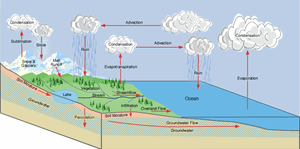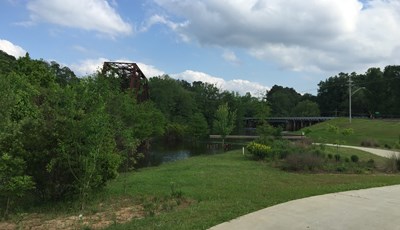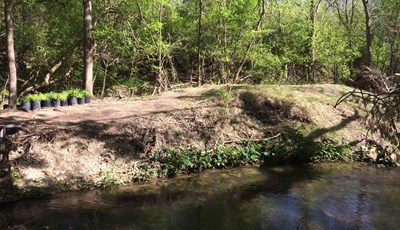The Texas Water Resources Institute has published its latest Annual Report, focusing on accomplishments and project highlights from 2019.
The Urban Riparian and Stream Restoration Program is an educational program focused on the emerging discipline of natural stream design. Natural design works to maintain or restore the primary stream functions of water transport, sediment transport and wildlife habitat though the use of selected vegetation and engineered placement of existing riparian features such as rocks or fallen timber.
One-day urban riparian and stream restoration trainings on assessing and restoring degraded urban riparian areas are offered and are geared toward professionals interested in restoration activities including those with municipalities, local/state/federal agencies, river authorities, water districts, land trusts and environmental organizations as well as consultants.
The morning sessions consist of educational presentations focused on protecting water quality and restoring riparian buffers, stream classification and restoration, watersheds and environmentally sensitive areas, followed by lunch. At the afternoon sessions, attendees perform a stream evaluation at a nearby stream and receive a certificate of completion.

This program also includes a demonstration project on the benefits of restored and healthy riparian areas.
The Texas Water Resources Institute, in collaboration with Texas A&M AgriLife Research and Extension Center at Dallas, Texas Riparian Association and the Texas Commission on Environmental Quality, are coordinating the Urban Riparian and Stream Restoration Program.
Lucas Gregory
lfgregory@ag.tamu.edu
Lucas Gregory, Ph.D., currently serves as associate director of research – physical sciences.
-
EM-127 Urban Stream Processes and Restoration Program Training Booklet
Sep 2019
Clare Entwistle, Nathan Glavy and Fouad Jaber
News
Fieldwork is fun but taking water training online means TWRI’s educational reach has expanded. Online formats also offer the opportunity for greater accessibility.
CANCELED: Urban Stream Processes and Restoration Training workshop on March 18 in Austin.
The Texas Water Resources Institute has published the newsletter, Natural Resources Training Courses Update, with a list of scheduled trainings for 2020.
The Texas Water Resources Institute’s Urban Riparian and Stream Restoration Program will host an Urban Stream Processes and Restoration Training workshop 8:30 a.m.-4 p.m. Feb. 20 in San Benito for professionals interested in conducting stream restoration projects around the South Texas area.
The Texas Water Resources Institute’s Urban Riparian and Stream Restoration Program will host Urban Stream Processes and Restoration trainings Nov. 14 in Waco and Nov. 19 in Corpus Christi for professionals interested in conducting stream restoration projects.
The Texas Water Resources Institute’s Urban Riparian and Stream Restoration Program will host an Urban Stream Processes and Restoration Training from 8:30 a.m.-4 p.m. Oct. 29 in New Braunfels for professionals interested in conducting stream restoration projects around the Interstate 35 corridor.
If you follow Texas Water Resources Institute on social media (@TxWRI), you may have noticed our monthly program spotlights, but in case you missed it, for the month of September the focus was on our Urban Riparian & Stream Restoration Program.
This month’s txH2O highlight is from the Fall 2017 issue of the magazine and focuses on the effectiveness of low impact development (LID) practices in reducing negative environmental impacts of urban growth.
The Urban Riparian and Stream Restoration Program of the Texas Water Resources Institute will host an Urban Stream Processes and Restoration training from 8:30 a.m.-4 p.m. Sept. 19 in McKinney for professionals interested in conducting stream restoration projects in and around the Dallas area.
The Texas Water Resources Institute’s Urban Riparian and Stream Restoration Program will host two workshops in April for professionals interested in conducting stream restoration projects.
The Texas Water Resources Institute (TWRI)’s Urban Riparian and Stream Restoration Program will host an Urban Stream Processes and Restoration workshop from 8:30 a.m. - 4 p.m. Nov. 29 in Belton.
From a math major to a watershed saver, Clare Entwistle, Texas Water Resources Institute (TWRI) research associate, knows that protecting riparian areas is important for the future of Texas.
The Texas Water Resources Institute’s Urban Riparian and Stream Restoration Program will host a workshop from 8:30 a.m.-4 p.m. Sept. 27 in Bryan for professionals interested in conducting stream restoration projects around the Bryan-College Station area.
The Texas Water Resources Institute’s Urban Riparian and Stream Restoration Program will host a workshop from 9 a.m.-4:30 p.m. Aug. 16 in The Woodlands for professionals interested in conducting stream restoration projects in and around the Houston area.
The Texas Water Resources Institute (TWRI) is hosting another Urban Riparian and Stream Restoration Program workshop from 8:30 a.m.-4 p.m. May 15 in the Woodlands for professionals interested in conducting stream restoration projects around the Houston area.
The Texas Water Resources Institute water team along with Ward Ling, Geronimo and Alligator Creek watershed coordinator, and volunteers recently planted native species along the Urban Riparian and Stream Restoration Program demonstration site located on Geronimo Creek at the Irma Lewis Seguin Outdoor Learning Center in Seguin, Texas.
The Texas Water Resources Institute’s Urban Riparian and Stream Restoration Program will host a workshop from 8:30 a.m.-4 p.m. April 11 in Austin for professionals interested in conducting stream restoration projects around the Austin area.
The new Urban Riparian and Stream Restoration Program, coordinated by the Texas Water Resources Institute in collaboration with the Texas A&M AgriLife Research Center in Dallas, is bringing awareness, education and the value of stream restoration to urban areas around Texas.
Riparian and natural resource professionals discussed current innovations and issues in riparian restoration and management at the Urban Riparian Symposium: Balancing the Challenges of Healthy Urban Streams Feb. 15-17 in Houston at Rice University’s BioScience Research Collaborative Building.
The Urban Riparian Symposium will be held Feb. 15-17, 2017, in Houston, and natural resource professionals are invited to attend, share ideas and discuss management and policy issues.
Even in cities, amidst the tall buildings, fast cars and busy people, there are still natural resources that need protection — particularly urban riparian areas, according to Nikki Dictson, Texas Water Resources Institute Extension program specialist. These vegetative buffers found along rivers and streams are complex ecosystems that include the land, plants, animals and network of streams within them.
Upcoming Trainings
There are no upcoming events
Subscribe to the Texas Riparian Listserv
Unsubscribe
This project is funded by the U.S. Environmental Protection Agency through the Texas Commission on Environmental Quality.




